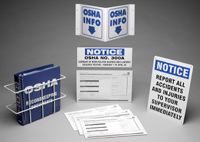 |
 |
| MSDS Topics |
Free Sites | FAQ's | Regulations | Glossary | Software | Suppliers |
| Books | Forum | Poll | Fun stuff | Quiz | Store | |
| MSDS and safety supplies | Search ALL our MSDS info | |||||
 | |||
 |
 |
 |
|
| Title: 04/29/1997 - Interpretation on the requirements of the hazard communication standard with regard to fiberglass products. | |
| Record Type: Interpretation | Standard Number: 1910.1200 |
April 29, 1997
Robert Horowitz, President
Victims of Fiberglass
Post Office Box 162646
Sacramento, California 95816-2646
Dear Mr. Horowitz:
This is in response to your letters of February 19, addressed to John B. Miles, Jr., Director, Directorate of Compliance Programs and to John Martonik, former Deputy Director, Directorate of Health Standards Programs on August 30, 1996, for the Occupational Safety and Health Administration (OSHA), regarding OSHA's Hazard Communication Standard (HCS) requirements for labeling an Owens Corning Fiberglass Corporation product trade named Miraflex. Please accept my apologies for the delay in responding to your previous letters.
|
Your letters indicate concern as to whether a cancer warning is required on the label for Miraflex products. The labeling requirements for specific products may vary depending upon end use. Products which are utilized by employees in the workplace rather than consumers are generally required to comply with 29 CFR 1910.1200. When these products contain fiberglass material, they may be required to include a warning of cancer on the label and disclose information relating to this hazard on the material safety data sheet. However, products which are considered to be consumer products, i.e. sold over the counter in retail establishments, are subject to labeling requirements of the Consumer Product Safety Act (15 U.S.C. 2051 et. seq.)(CPS Act) and, therefore, specifically exempt from the labeling requirements of the OSHA's Hazard Communication Standard pursuant to 29 CFR 1910.1200(b)(5)(v). OSHA contacted Owens Corning World Headquarters and was informed that the vast majority of Miraflex is sold as a consumer product, trade named PinkPlus, to retailers for use by home owners in do-it-yourself projects. For the specific label carcinogen warning requirements under the CPS Act, I suggest you contact the Consumer Product Safety Commission. Owens Corning also provided a photocopy of a product safety and health information sheet for Miraflex PinkPlus which does contain information about cancer. This sheet is available to employers who utilize PinkPlus in a workplace setting. I hope this clarifies OSHA's position on the requirements of the hazard communication standard with regard to fiberglass products.
|  Get your MSDS binders, posters, signs and more at Safety Emporium. |
Sincerely,
Stephen Mallinger, Acting Director
Office of Health Compliance Assistance
February 19, 1997
John Miles, Director
Directorate of Compliance Programs
U.S. Dept. Of Labor, OSHA
200 Constitution Ave., N.W. N3468
Washington, D.C. 20210
 Comply with OSHA injury-reporting requirements with centers and forms from Safety Emporium. |
Dear John Miles: The attached letter was sent to John Martonik nearly six months ago, and I have received no response. I expect, as a U.S. citizen and as the chairman of a non-profit group involved in the public health arena, that when I write a public official and ask them to enforce established laws, at the very least, I will get a response. Now, I am told I must direct my query to you. Sir, the lawless Owens-Corning Corp. has clearly violated the law with respect to the labeling of its "Miraflex" product with the cancer hazard label which OSHA requires on fiberglass products. Owens Corning admitted in the article that the new product is not fundamentally different than their old, cancer causing insulation. Since they have lied repeatedly to the public and to OSHA, and since they care not for public health and the safety of those who buy their product, they must be punished. Therefore, I ask you, as I asked Mr. Martonik six months ago, to please enforce your laws, and to fine Owens Corning for its premeditated and willful violation of OSHA regulations.
|
Because I have already waited six months for a reply, I ask you to please respond to this letter within 30 days. Thank you.
Sincerely,
Robert Horowitz
Chairman, VOF
August 30, 1996
John Martonik
Deputy Director of Health Standards
Occupational Safety and Health Administration
U.S. Department of Labor
200 Constitution Ave., N.W., N3718
Washington, D.C. 20210
Dear John Martonik:
I am writing today to request what my predecessor, Richard Munson, requested and obtained from Gerald Scannell and OSHA in 1988: to make the Owens Corning Fiberglass Corp. follow the law with respect to the labeling of its products as a cancer hazard.
Please consider this a petition to examine O-C's Miraflex fiber to see whether it deserves the cancer warning label all other fiberglass insulation products sold in this country are required to have. O-C originally claimed their new fiber was fundamentally different than the old, and used that as a justification to avoid labeling their product with the OSHA mandated label. This was a dubious claim from the beginning.
Per the enclosed article recently published in "This Old House" magazine, O-C has now publicly admitted their claim that Miraflex does not break into respirable fibers to be fraudulent. Since the fibers are no different than other glass insulation fibers, they clearly deserve to carry the cancer warning label. In addition, since O-C deliberately misled the public and OSHA about the nature of this product, it should be subject to a hefty fine as punishment.
I certainly would appreciate hearing back from you as soon as possible regarding OSHA's response to this letter and the obvious fraud perpetrated against the American public by Owens Corning.
Sincerely,
Robert Horowitz
Chairman, Victims of Fiberglass
The official, public domain, OSHA version of this document is available at http://www.osha.gov/pls/oshaweb/owadisp.show_document?p_table=INTERPRETATIONS&p_id=22398&p_text_version=FALSE